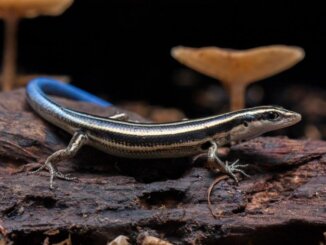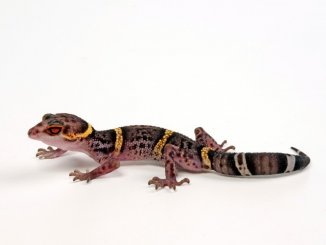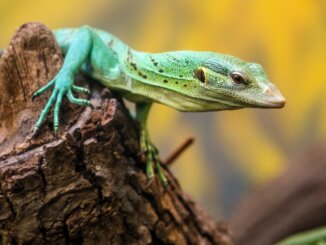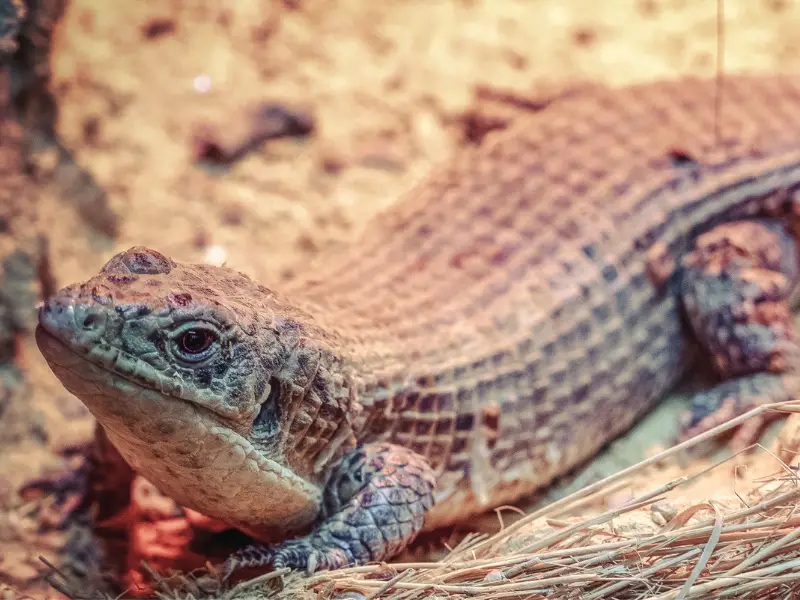
A Sudan Plated Lizard is a medium-sized lizard with a stout body, short limbs, and a broad tail.
Also known as the Western plated lizard, Great plated lizard or Broadley’s rough-Scaled plated lizard, it is found in eastern and central Africa.
This reptile makes an unusual pet and can grow up to 24” long.
If you are new to the world of reptile care and have chosen this lizard as your pet, you’ll need some information about its care.
In this ultimate care guide for the Sudan Plated Lizard, you’ll learn all you need to know about this amazing reptile.
Sudan Plated Lizard Overview
| Common name | Sudan plated lizard, Western plated lizard, Great plated lizard, Broadley's rough-Scaled plated lizard |
| Scientific name | Broadleysaurus major |
| Natural habitat | African woodlands and savannas |
| Adult size | 20-24 inches |
| Average lifespan | Up to 20 years |
| Diet | Omnivores |
| Housing | Terrarium (48"L x 24"W x 24"H) |
| Experience | Intermediate, but they are easily tamed |
Origin
Sudan plated lizards are endemic to the continent of Africa.
They are found in eastern and central Africa, including the countries of Sudan, Tanzania, Kenya, Mozambique, and the island archipelago of Zanzibar.
They love to hide out in the crevices of rocks. Sudan plated lizards are often spotted in rocky areas in coastal woodlands and both wet and dry savannahs.
Appearance And Behavior
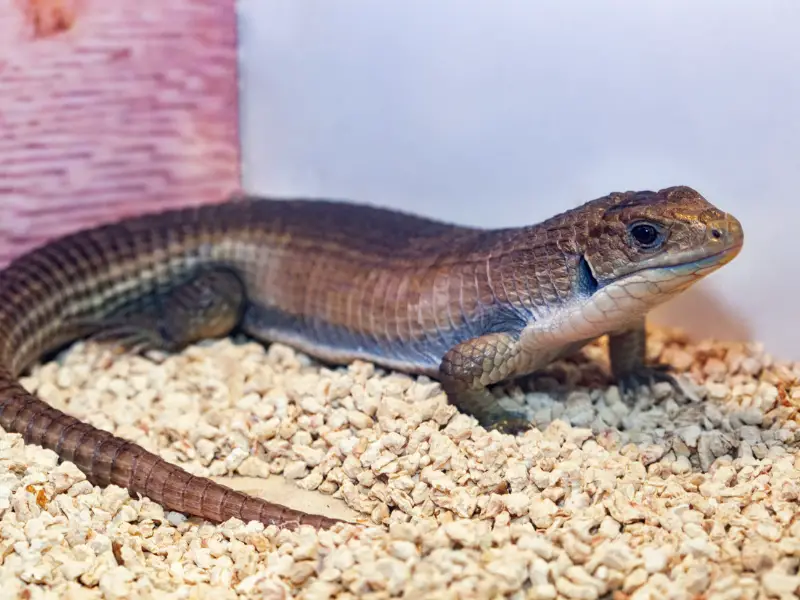
Easily identified by its unique ‘armored appearance’, it has plate-like scales across its body and tail and head shields fused to its skull.
In captivity, a Sudan plated lizard will be a bit shy at first. It is easily tamed though and makes a wonderful pet.
Although not particularly social creatures in the wild, Sudan plated lizards can often be found in groups. This is due to reasons of necessity like breeding and sharing feeding grounds or a water source.
Size And Lifespan
Sudan plated lizards generally grow between 16 – 27″ in length.
They can live up to 20 years and older. In captivity, you can reasonably hope for 10 years but with proper care, your cold-blooded friend may live far longer!
Temperament
Sudan plated lizards are not naturally social reptiles, so you may worry that your lizard will always stay this way. However, although they are shy at first, these docile reptiles soon become tame.
A Sudan plated lizard is not usually aggressive at all and will make a fantastic pet. So be gentle and patient in handling your pet and he will soon become accustomed to you.
Housing A Sudan Plated Lizard
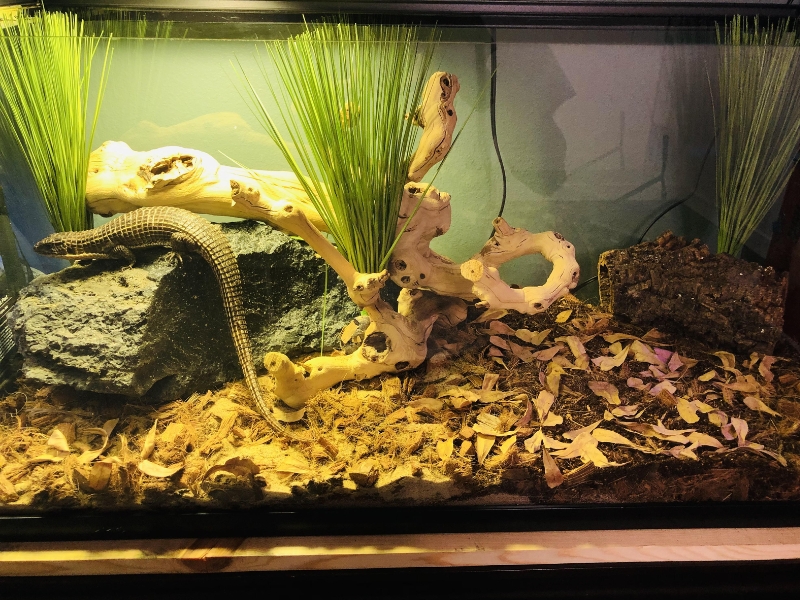
In their natural habitat, Sudan plated lizards like to take shelter in rocky crevices in the savanna. Try to recreate this in a terrarium with a few small rocks piled up on each other that it can climb onto and shelter behind.
Enclosure Size
There are 30 species of plated lizards, and these African-plated lizards are the largest. To ensure that this lizard has enough room to play, a terrarium with dimensions of 48″L x 24″W x 24″H would be ideal.
At least 4-6” of substrate will be needed so that your pet can dig and burrow. Twice this will be needed for a tall enclosure.
Lighting
Sudan plated lizards require UV lighting and heat for their general well-being, but especially for their metabolisms to work correctly.
A halogen heat lamp can mimic the way that the sun provides light and heat from above. Keep this light source on for up to 12 hours a day.
A 75-100w halogen floodlight bulb is suitable if the substrate surface is 12” away. The wattage depends on factors like enclosure size and ambient room temperature.
Position it over one side of the tank, so that your lizard may move to the ‘cool side when necessary.
Temperature And Humidity
The tropical Savanna biome in Africa, where these reptiles are found, is a wet-dry tropical climate. There is a warm season and a cool season.
In your terrarium, you’ll need to create an artificial basking area of up to 125°F degrees with a halogen lamp. The rest of the enclosure can be 85-88 degrees, falling to 75 degrees at night.
A range of 20-80% humidity will work well as these reptiles are native to areas that average 40-60% ambient (air) humidity. You’ll need a hygrometer to measure the humidity.
Substrate And Decoration
When choosing the substrate for the terrarium floor, mimic their natural conditions. In the wild, this reptile’s body has adapted to navigating sandy soil. That’s good news for you, as this is inexpensive.
Get play sand from your local DIY depot and lay this over some clay at a ratio of 80:20. These reptiles love to dig and burrow, so aim for at least 4 inches of substrate.
Alternatively, purchase a Sahara-type bio-active substrate mix. Create a bedding area as well as hiding places that mimic your reptile’s natural favorite hangout. Use small, smooth rocks to form a hideout, layered to create rock crevices.
Cleaning
Keep the cage clean and remove old food or waste daily, but don’t use harsh detergents in the enclosure.
Regularly change the water in the bowl, as these reptiles like to soak themselves in it. Don’t use a deep bowl or you’ll risk your reptile drowning.
Replace the substrate every 3-4 months to keep any build-up of bacteria at bay.
Sudan Plated Lizard Care
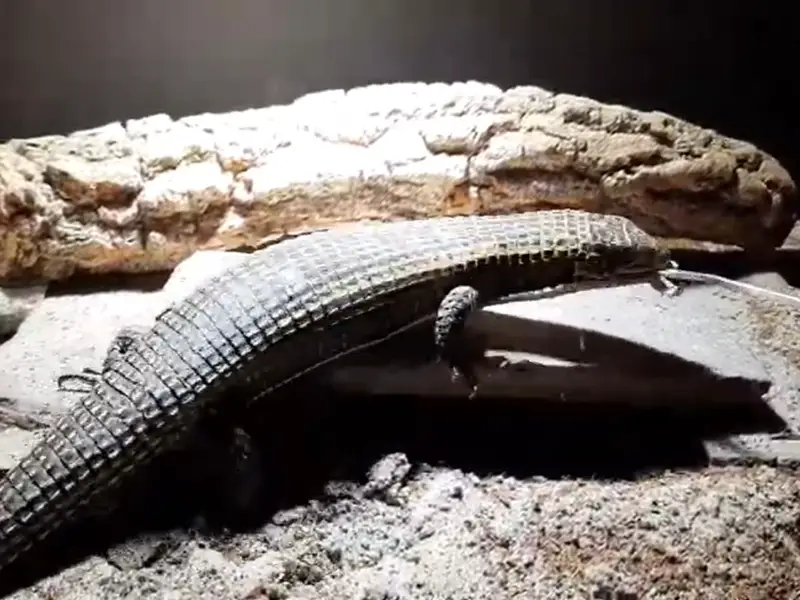
Sudan plated lizards are relatively easy to care for, as long as you regulate their temperature and humidity to mimic their natural habitat. Anyone with intermediate reptile care experience will do fine.
Food And Water
If you’re a new reptile owner, you’ll be wondering, “What do lizards eat?”
Insects are a great source of nutrition for your lizard. But veggies like a rocket, bok choy, kale, and watercress are also ideal for feeding.
Avoid acidic foods like citrus fruits. They cause digestive issues and even ulcers.
Crickets, mealworms, darkling beetles, Dubia and Discoid roaches as well as silkworms are all safe feeding choices.
Feed your lizard as many insects as it can eat consecutively in 5 minutes, and not more than that. As a general rule, the size of these insects should not exceed the space between your lizard’s eyes.
Placing the insects for feeding in the enclosure will keep your pet’s hunting instincts alive and well.
But only do this once you have become accustomed to the amount your lizard eats in a day. Until then, place live insects in a bowl from which they can’t escape.
If you want to give your pet a treat, try a boiled chicken or quail egg. Limit this to once a month, though.
DO NOT feed your Sudan plated lizard avocados, onions, rhubarb, or mushrooms, as they are poisonous to this reptile.
Also, don’t overfeed them. If you miss a feeding, don’t stress! The odd skipped meal won’t harm them. They don’t need much food to survive and become sick from overeating anyway.
For drinking, provide a shallow bowl or saucer in the enclosure. If your local tap water is of good quality, it’s safe for your pet to drink. You can also use still spring or mineral water. Avoid distilled water.
Handling
A Sudan plated lizard is a highly active reptile. To keep it healthy, provide the right amount of heat, cool, and humidity as well as room to play.
They don’t mind being handled, but it will take some getting used to. Fortunately, they are most active during the day, just like we are.
If you’d like to handle your pet Sudan plated lizard, you’ll need to get them used to your hands, first. Use a towel to pick them up if they are nervous at first.
Don’t handle them for more than five minutes at a time, until they’re happy with it.
Ignoring this advice can cause them distress and is one of the many mistakes that beginners make with pet lizards.
Common Health Issues
If your Sudan plated lizard suddenly starts to lose weight rapidly, this can be a sign of stress or illness. Weigh your lizard regularly and take note of any changes.
Calcium loading is essential to Sudan plated lizard care. Because you’re using UV lighting for your lizard, use a plain reptile calcium powder without phosphorus or vitamin D added.
Dust this on all insects for feeding. Use supplements specified for reptile use.
Keeping More Than One In An Enclosure
Don’t do it! These reptiles are solitary animals in the wild, and captivity will do nothing to change that. You’ll cause unnecessary stress and fighting in reptiles that are usually not aggressive.
A larger enclosure will not change the outcome.
Breeding
Males of this species become highly territorial during the breeding season. They will fight with any other males if kept in the same enclosure.
If breeding a pair of Sudan Plated Lizards, remove the female and her young once they have hatched.
Female Sudan plated lizards lay 2-4 eggs, usually in moist areas under logs, in rock crevices, or in soil. The eggs get incubated for 3-4 months.
A Sudan plated lizard measures 3.9-5.5 inches when hatched.
Choosing And Buying A Sudan Plated Lizard
If you’ve decided to get a Sudan plated lizard then great choice! These reptiles are fairly easy to care for and take well to handling.
Just be sure that the enclosure environment mimics its natural habitat so that your scaly friend will thrive.
It can cost up to $600 and even more, to get all you’ll need for your Sudan plated lizard.
Remember to only buy this reptile from a reputable reptile dealer, to ensure that you receive a healthy pet.

